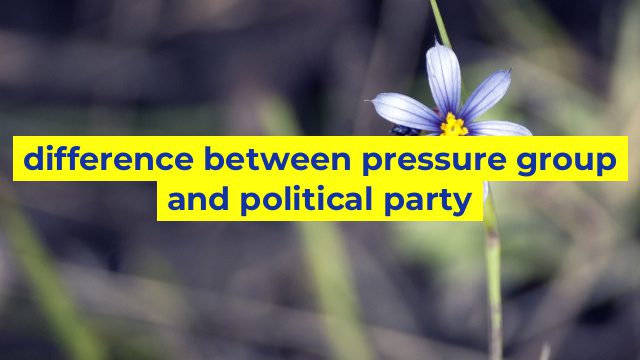Understanding the Difference Between Pressure Group and Political Party
When it comes to politics, there are a variety of organizations that people can join to advocate for their beliefs or push for policies they support. Two common types of organizations in the political realm are pressure groups and political parties. While these groups may share some similarities, there are also several key differences between them that are worth noting.
What is a Pressure Group?
A pressure group, also known as an interest group or lobby group, is a type of organization that aims to influence government policymakers on a specific issue or set of issues. Pressure groups come in various forms, ranging from large organizations with thousands of members, to small interest groups representing a niche segment of the population. Some examples of pressure groups include environmental organizations, labor unions, and civil rights groups.
One key aspect of pressure groups is that they do not aim to take control of the government or hold public office. Instead, their main goal is to influence those in power and pressure them to enact policies that align with the group’s ideals. Pressure groups often use tactics such as organizing protests and marches, writing letters and petitions, and lobbying elected officials to achieve their goals.
What is a Political Party?
A political party, on the other hand, is an organization that aims to contest elections and gain control of the government. Political parties have specific platforms and ideologies that they promote and use to appeal to voters. They also have a hierarchical structure with leaders and elected officials who work within the government.
Political parties participate in elections and often have a range of candidates running for office at different levels, including local, state, and national levels. Winning elections allows a party to gain power and influence policy decisions, making it a significant force in the government.
The Differences Between Pressure Groups and Political Parties
While both pressure groups and political parties aim to impact policy decisions, there are several key differences between the two. Firstly, pressure groups do not aim to take control of the government, while political parties actively seek government control.
Secondly, pressure groups are issue-specific, focusing on a particular set of concerns or interests, while political parties have a broader platform that covers a range of issues.
Thirdly, pressure groups have more capacity to influence the government because they do not need to win elections. Political parties, on the other hand, require electoral victories to gain power and implement their policies.
Conclusion
In conclusion, the main difference between pressure groups and political parties is their main objective. While pressure groups aim to influence policy decisions from outside the government, political parties seek to gain control of the government through their platform and elected officials. Understanding these differences can help individuals better understand the political landscape and how different organizations work to achieve their goals.
Table difference between pressure group and political party
| Pressure Group | Political Party |
|---|---|
| A non-governmental organization or entity that aims to influence public policy and decision-making processes. | An institution that seeks to gain political power through participation in elections and govern a country or region. |
| They do not have legal recognition and cannot contest elections or form governments. | They are legally recognized and can contest elections to form governments. |
| Members join based on common interests or goals and do not necessarily have to agree on all issues. | Members usually join based on a shared ideology or political platform and must agree on most issues. |
| They use nonviolent means such as lobbying, protests, and petitions to influence decision-makers. | They use electoral means such as campaigns, advertising, and debates to persuade voters to support their candidates. |
| They may focus on a specific issue or set of issues, such as human rights, environmental protection, or healthcare. | They have a broader focus, covering a wide range of issues such as economy, education, foreign policy, and social issues. |

